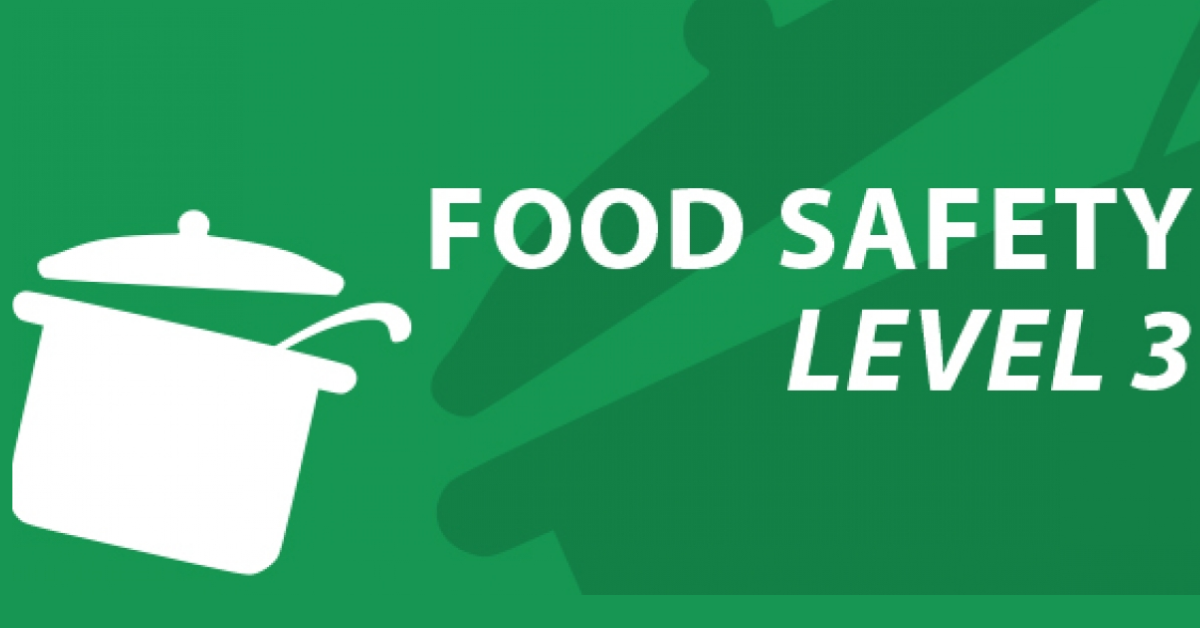The Complete Guide to Food Safety Course Level 3: What It Is, Who It’s For, and Why It Matters
If you are working in or aiming to enter the food industry—whether in restaurants, catering, food retail, manufacturing, or institutional kitchens—then a Food Safety Course Level 3 can be a game changer for your professional growth. This course is designed to provide comprehensive knowledge and practical skills so that food handlers, supervisors, and quality staff can not only follow safe food practices, but also actively monitor, audit, manage nonconformances, and ensure compliance with food safety systems. In this article, we will explore what a Level 3 course typically entails, who should take it, its benefits, the content breakdown, modes of delivery, assessment, and how to choose a good provider.
What Is Food Safety Course Level 3?
Food Safety Course Level 3 is an advanced training program that goes beyond the basics of food hygiene and safety. While foundational courses (Level 1 or 2 in many systems) teach safe handling, cross-contamination control, personal hygiene, storage, etc., Level 3 empowers participants with deeper supervisory and audit-level competencies. You learn to inspect, monitor, identify nonconformances, understand and operate pre-requisite programs (PRPs), and implement a Food Safety Management System (FSMS) based on HACCP (Hazard Analysis and Critical Control Points). The goal is to elevate food safety from simple compliance to proactive management.
In a typical Level 3 course, participants will be able to:
-
Conduct thorough food safety and hygiene inspections and audits
-
Identify hygiene lapses and non-conformances, and apply corrective actions
-
Understand and maintain pre-requisite programs that underpin food safety
-
Develop, implement, and monitor a Food Safety Management System aligned with HACCP principles
The training is especially relevant for staff who supervise food operations, quality assurance teams, or those who aspire to leadership roles in food establishments.
At the end of the course, participants should be capable of applying their knowledge to real-world environments—ensuring that the food operations under their watch meet regulatory standards and maintain high consumer safety.
Who Should Take Food Safety Level 3?
Not everyone working around food needs to take Level 3. This course is most suitable for:
-
Supervisors, managers, and team leads in food service, retail, or catering
-
Quality assurance and quality control personnel in food processing or manufacturing
-
Safety and compliance officers in food establishments
-
Consultants or auditors tasked with inspecting food businesses
-
Food business owners who wish to self-audit or elevate their food safety practices
If your role involves oversight, auditing, or decision-making in food operations, a Level 3 course is often recommended (or even mandated, depending on local regulations).
Benefits of Completing Food Safety Course Level 3
1. Stronger Food Safety Culture
Beyond procedural compliance, Level 3 training encourages a preventive mindset. Supervisors learn to spot lapses, embed good practice, and maintain standards proactively.
2. Better Compliance & Audit Readiness
Many regulatory bodies require or prefer businesses to have supervisory staff competent in higher-level food safety. Having certified personnel gives confidence that your operations are audit-ready.
3. Career Advancement & Credibility
Holding a Level 3 certification signals professionalism and expertise. It can translate into promotions, higher remuneration, or more responsibility within the organization.
4. Reduced Food Safety Incidents
With better detection of nonconformances and quicker corrective actions, you will reduce the risk of foodborne illness outbreaks, recalls, or rejections from regulatory inspections.
5. Holistic Understanding of FSMS & HACCP
The course doesn’t just teach rules; it teaches frameworks — how to build, monitor, review, and improve food safety systems over time.
Typical Course Structure & Content
Though the precise syllabus may vary among providers, here is a common breakdown of topics and structure in a Level 3 course:
| Module / Topic | Key Learning Points |
|---|---|
| Food Safety & Hygiene Regulatory Requirements | Legal obligations, food safety laws, roles and responsibilities |
| Pre-requisite Programs (PRPs) | Cleaning, pest control, facility maintenance, supplier control |
| Food Safety Inspections & Audits | Checklists, inspection techniques, audit protocols |
| Identification of Hygiene Lapses | Cross-contamination, temperature abuses, personal hygiene failures |
| Corrective Actions & Non-conformance Handling | Root cause analysis, corrective/preventive actions, follow-up |
| FSMS & HACCP Principles | Hazard analysis, identifying Critical Control Points, monitoring, verification, validation, documentation |
| Implementation & Review | Putting theory into practice, monitoring performance, continual improvement |
A well-structured Level 3 course will combine theoretical sessions with case studies, group work, and practical exercises (e.g. mock audits). Some providers may conduct site visits or in-kitchen walkthroughs.
In many cases, the duration is about 21 hours, often spread across three consecutive days (including breaks and assessment time). The final assessment usually includes both written and practical components (e.g. 2 hours) so that participants can demonstrate both understanding and applied skills.
Delivery Modes: What to Look For
Training providers may offer different modes of delivery:
-
In-person / Classroom Training
This is traditional, with face-to-face teaching, group interaction, role play, and practical audits or walkthroughs. Ideal for hands-on learning and immediate feedback. -
Blended / Hybrid Training
Some courses combine online theory modules with in-person practical sessions. This allows flexibility for learners who cannot commit to full in-person classes. -
Fully Online / Virtual Instructor-Led
For remote learners or in regions with limited access, the full course—including practical demonstrations via video or virtual scenarios—can be delivered online. -
Onsite / In-house Training
For businesses with multiple staff, a training provider may come to your facility and tailor the course to your specific operations.
When choosing a mode, ensure that practical assessments are included—not just a theory exam. The ability to apply learning on the ground is crucial.
Assessment & Certification
A quality Level 3 course will assess learners via:
-
Written exam / Quiz: Multiple choice, short answer, or scenario-based questions to test theoretical understanding
-
Practical assessment / Audit exercise: A hands-on exercise or walk-through in a simulated or real food environment, checking for nonconformances, recommending corrective actions
Passing both components is often required to gain the certification. Always check whether the certification is formally recognized by relevant food safety authorities or local regulatory bodies in your jurisdiction.
Choosing a Good Provider
Not all Level 3 courses are equal. When selecting a provider, consider:
-
Accreditation / Recognition: Ensure the provider is recognized or accredited by a relevant food authority or professional body in your region.
-
Practical Focus: The course should not be purely theoretical. It should include audits, real-world case studies, and hands-on exercises.
-
Trainer Expertise: Trainers should have experience in food safety, auditing, and real industry work—not just academic credentials.
-
Class Size & Interaction: Small class sizes allow more interaction, feedback, and meaningful discussion.
-
Support Materials: Check if the provider offers updated course materials, templates (checklists, corrective action forms), and post-course support.
-
Mode & Flexibility: If you can’t commit to fixed classroom sessions, check for blended or online options that still include the necessary practical component.
-
Cost vs Value: Compare course fees against what is included (materials, assessment, certification, extra support) rather than only comparing base fee.
Common Challenges & Suggestions
Challenge: Translating theory into practice
Many learners grasp the concepts, but struggle when applying them in real food operations.
Suggestion: Practice mock audits, use real facility walk-throughs, ask “why” for every control measure, and work with supervisors in your own workplace to test changes.
Challenge: Keeping up with regulatory changes
Food safety laws and standards can evolve.
Suggestion: Choose providers who update their curriculum regularly and provide post-course updates or refresher sessions.
Challenge: Resistance in the organization
Some staff or management may resist procedural changes recommended by a newly trained person.
Suggestion: Use a collaborative approach—share audit findings, involve staff in corrective actions, and communicate benefits (e.g. fewer rejections, better reputation, lower risk).
Real-World Application & Use Cases
Let’s consider some practical ways a Level 3 certificate can be applied:
-
A restaurant chain appoints you as the hygiene supervisor; you perform weekly internal hygiene audits, identify nonconformances, and follow up on corrective actions.
-
In a food processing plant, you help maintain PRPs like cleaning, maintenance, pest control, and validate the HACCP plan annually.
-
A food business applying for regulatory licensing may need to show that key personnel hold advanced food safety certification as part of their documentation.
-
You may act as a third-party internal auditor or consultant, inspecting smaller food businesses and advising on compliance gaps.
-
When a foodborne incident occurs, you serve as the lead investigator, tracing hazards, assessing root causes, and recommending preventive measures.
Conclusion
A Food Safety Course Level 3 is more than just an advanced certification—it’s a capability builder. It transforms you from a food handler into a food safety manager, auditor, or supervisor, able to identify lapses, enforce standards, and uphold consumer safety with confidence. Whether your motivation is career advancement, regulatory compliance, or improving your business’s risk profile, investing in a robust Level 3 course can pay dividends.
Before enrolling, carefully evaluate providers based on accreditation, practical content, trainer experience, and flexibility. And once you’re certified, view it as only the beginning—food safety is a journey of continual learning and system improvement.







